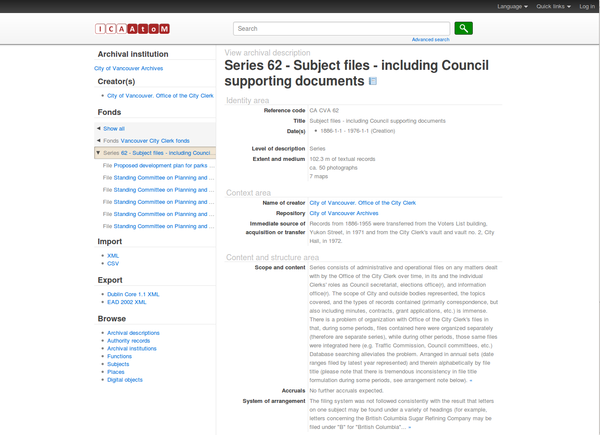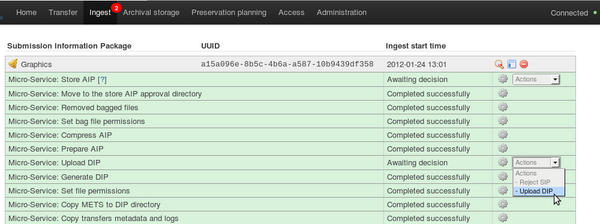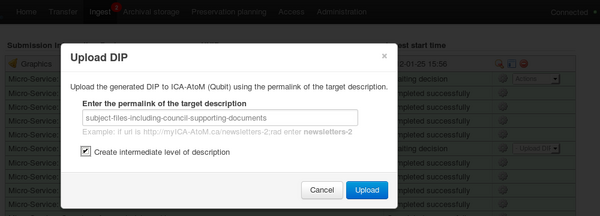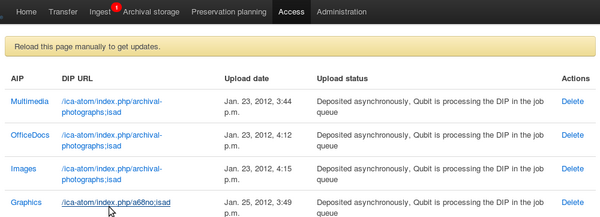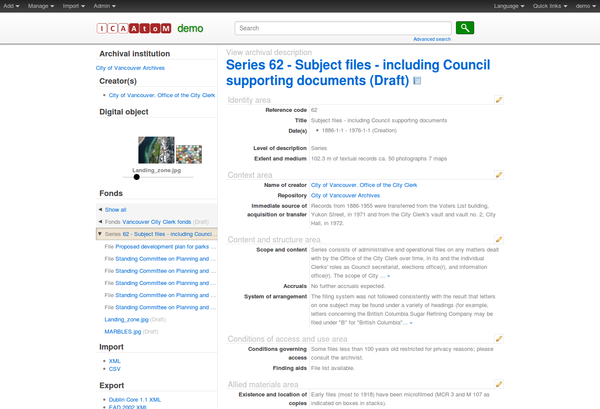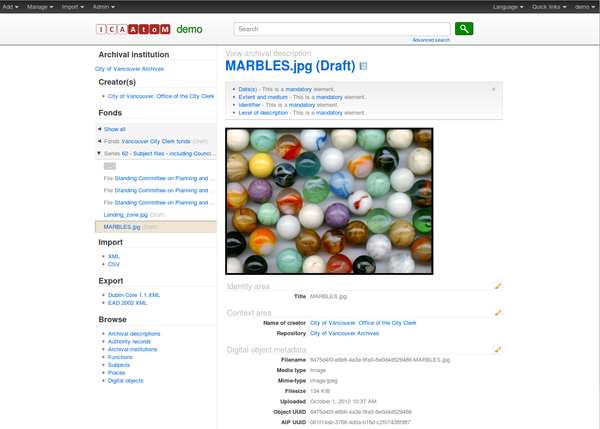Difference between revisions of "UM access"
Jump to navigation
Jump to search
| Line 19: | Line 19: | ||
== Upload DIP == | == Upload DIP == | ||
| − | In this example, we will upload a DIP to the sample description shown in figure 1. This assumes that the user has processed a SIP and generated a DIP from it | + | In this example, we will upload a DIP to the sample description shown in figure 1. This assumes that the user has processed a SIP and generated a DIP from it. [[Image:access1g.png|600px|right|thumb|'''Figure 2''' Select "Upload DIP" in the Actions drop-down menu]] |
| − | + | #In the ingest tab, select "Upload DIP" in the upload DIP Actions drop-down menu (''figure 1'''). | |
#A dialogue box will appear ('''figure 3'''). | #A dialogue box will appear ('''figure 3'''). | ||
#*To upload the DIP to the series description pictured in figure 1, enter the permalink of the description's URL in the dialogue box: ''subject-files-including-supporting-documents'' | #*To upload the DIP to the series description pictured in figure 1, enter the permalink of the description's URL in the dialogue box: ''subject-files-including-supporting-documents'' | ||
#*Click on "Create intermediate level of description" to create an archival description from the Dublin Core metadata you entered during ingest. | #*Click on "Create intermediate level of description" to create an archival description from the Dublin Core metadata you entered during ingest. | ||
| − | #**If you chose not to click this box, the digital objects would be uploaded as immediate child levels of the series description to which the DIP is being uploaded. This might be useful for, for example, a collection of digitized images which was not hierarchically arranged into lower levels of description. | + | #**If you chose not to click this box, the digital objects would be uploaded as immediate child levels of the series description to which the DIP is being uploaded. This might be useful for, for example, a collection of digitized images which was not hierarchically arranged into lower levels of description. |
#Click the blue "Upload" button. | #Click the blue "Upload" button. | ||
| − | #When the DIP has finished uploading, open the Access tab in the dashboard. This tab shows the AIP and its uploaded DIP. Click on the DIP URL to go to the uploaded DIP in Qubit ('''figure 4'''). | + | #When the DIP has finished uploading, open the Access tab in the dashboard. This tab shows the AIP and its uploaded DIP. Click on the DIP URL to go to the uploaded DIP in Qubit ('''figure 4'''). |
#If you are not already logged in to Qubit you will need to log in using the email ''demo@example.com'' and the password ''demo''. | #If you are not already logged in to Qubit you will need to log in using the email ''demo@example.com'' and the password ''demo''. | ||
#You will see an archival description with the metadata you added during ingest, displayed in the context of the series to which the DIP was uploaded ('''figure 5'''). To view an individual digital object, scroll through the thumbnails on the left of the screen and click on an image. | #You will see an archival description with the metadata you added during ingest, displayed in the context of the series to which the DIP was uploaded ('''figure 5'''). To view an individual digital object, scroll through the thumbnails on the left of the screen and click on an image. | ||
#'''Figure 6''' shows the digital object displayed in Qubit. Clicking on the image will open the uploaded object. | #'''Figure 6''' shows the digital object displayed in Qubit. Clicking on the image will open the uploaded object. | ||
| + | [[Image:access2g.png|600px|right|thumb|'''Figure 3''' The Upload DIP dialogue box]] | ||
| + | [[Image:access3g.png|600px|right|thumb|'''Figure 4''' The Access tab showing AIPs and their uploaded DIPs. Click on a DIP URL to go to the uploaded DIP in Qubit]] | ||
[[Image:qubit2g.png|600px|right|thumb|'''Figure 5''' The uploaded DIP: an archival description with digital objects attached as immediate child-level objects]] | [[Image:qubit2g.png|600px|right|thumb|'''Figure 5''' The uploaded DIP: an archival description with digital objects attached as immediate child-level objects]] | ||
| − | [[Image:qubit3g.png|600px|right|thumb|'''Figure | + | [[Image:qubit3g.png|600px|right|thumb|'''Figure 6''' The digital object displayed in Qubit. Clicking on the image will open the uploaded object]] |
</div> | </div> | ||
Revision as of 18:59, 25 January 2012
Main Page > Documentation > User manual > User manual 0.8 > Access
General description
During ingest, access copies of digital objects are generated and packaged into a DIP (Dissemination Information Package). The user uploads the DIP to the access system
Default access system
An information management tool called Qubit is bundled with Archivematica as a default access system. Qubit supports standards-compliant hierarchical archival description and digital object management. A small amount of sample data has been added to Qubit, including the Vancouver City Clerk fonds (figure 1).
Upload DIP
In this example, we will upload a DIP to the sample description shown in figure 1. This assumes that the user has processed a SIP and generated a DIP from it.
- In the ingest tab, select "Upload DIP" in the upload DIP Actions drop-down menu (figure 1').
- A dialogue box will appear (figure 3).
- To upload the DIP to the series description pictured in figure 1, enter the permalink of the description's URL in the dialogue box: subject-files-including-supporting-documents
- Click on "Create intermediate level of description" to create an archival description from the Dublin Core metadata you entered during ingest.
- If you chose not to click this box, the digital objects would be uploaded as immediate child levels of the series description to which the DIP is being uploaded. This might be useful for, for example, a collection of digitized images which was not hierarchically arranged into lower levels of description.
- Click the blue "Upload" button.
- When the DIP has finished uploading, open the Access tab in the dashboard. This tab shows the AIP and its uploaded DIP. Click on the DIP URL to go to the uploaded DIP in Qubit (figure 4).
- If you are not already logged in to Qubit you will need to log in using the email demo@example.com and the password demo.
- You will see an archival description with the metadata you added during ingest, displayed in the context of the series to which the DIP was uploaded (figure 5). To view an individual digital object, scroll through the thumbnails on the left of the screen and click on an image.
- Figure 6 shows the digital object displayed in Qubit. Clicking on the image will open the uploaded object.
